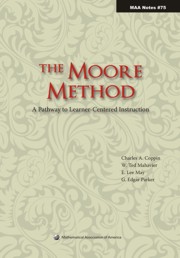Book contents
- Frontmatter
- Contents
- Dedication
- Acknowledgements
- 1 Introduction
- 2 Moore's Moore Method
- 3 What is the Moore Method?
- 4 On Culture
- 5 Development and Selection of Materials
- 6 In the Classroom
- 7 Grading
- 8 Why Use the Moore Method?
- 9 Evaluation and Assessment: Effectiveness of the Method
- 10 Frequently Asked Questions
- Appendices
- About the Authors
- References
- Index
3 - What is the Moore Method?
- Frontmatter
- Contents
- Dedication
- Acknowledgements
- 1 Introduction
- 2 Moore's Moore Method
- 3 What is the Moore Method?
- 4 On Culture
- 5 Development and Selection of Materials
- 6 In the Classroom
- 7 Grading
- 8 Why Use the Moore Method?
- 9 Evaluation and Assessment: Effectiveness of the Method
- 10 Frequently Asked Questions
- Appendices
- About the Authors
- References
- Index
Summary
“There is one effective way of learning mathematics and that is by DOING it. This will always be my point of view.”
—H.J. Ettlinger, circa 1979 Chairman, Department of Pure Mathematics, University of TexasThe Moore Method, as practiced by Moore himself, relied on the rigid policies delineated in Chapter 2 on page 9. The consequences of these policies, along with Moore's own unique personality, created the learning environment he desired. Since the 1950s, many individuals assumed that these rules, and these rules alone, defined the method and applied the rules with widely varying results. Moore's rules alone are probably not adequate to define the method and assure a successful implementation. Therefore, in describing the Moore Method as second- and third-generation practitioners, we articulate our commonalities by describing the method in terms of the learning environment and student outcomes we hope to create rather than by the rules we establish for our students. Six principles common to our four versions of Moore Method are:
the goal of elevating students from recipients to creators of knowledge,
the commitment to teaching by letting students discover the power of their minds,
the attitude that every student can and will do mathematics,
the time for students to discover, present, and debate mathematics,
the careful matching of problems and material to students, and
the material, varying widely in difficulty, to cover a significant body of knowledge.
The essays that follow elucidate different modes of execution that can occur within this common philosophy.
- Type
- Chapter
- Information
- The Moore MethodA Pathway to Learner-Centered Instruction, pp. 13 - 28Publisher: Mathematical Association of AmericaPrint publication year: 2009



